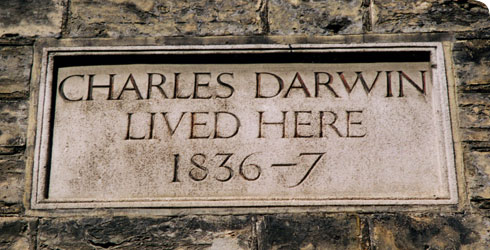Darwin's Britain
Many places in Britain have a connection with Darwin's life and work, from Shrewsbury where he grew up, to Plymouth where the Beagle set sail in 1831.
Find out about the places that inspired his scientific work and the monuments to his life that you can visit.
-

Downe, Bromley, Kent
Darwin moved to Down House with his growing family in September 1842, and lived here for 40 years until he died in 1882.
-

Cambridge
Darwin studied theology at Cambridge University but also spent much time developing his passion for natural history.
-

Shrewsbury, Shropshire
Charles Darwin was born and raised in the family home in Shrewsbury and also attended school in the town.
-

London locations linked to Darwin
Darwin lived in several locations in London and is buried in Westminster Abbey.
-

London Societies linked to Darwin
After his return from the Beagle voyage, Darwin developed contacts with many eminent scientists and scientific societies based in London.
-

Edinburgh
Darwin spent two years studying medicine at Edinburgh University.
-

Glen Roy, Scotland
Darwin studied the unique geology of Glen Roy when he returned from the Beagle voyage.
-

Oxford
Oxford was the location of the infamous debate on evolution and religion in 1860.
-

Malvern, Worcestershire
Darwin had several long stays at this spa town between 1849 and 1851, and again in 1863.
-

Maer Hall, near Stoke-on-Trent, Staffordshire
Maer Hall was the Wedgwood family home, located near to the Wedgwood factory.
-

Ilkley, nr Otley, Yorkshire
Darwin was staying in Ilkley and taking water cure treatments when On the Origin of Species was published in November 1859.
-

North and Mid Wales
Darwin visited Wales many times during his lifetime for holidays and field trips.
-

Moor Park, nr Farnham, Surrey
Moor Park was a water cure establishment that Darwin visited often between 1857 and 1859.
-

Plymouth, Devon
The Beagle set sail from Plymouth in 1831 with 22-year-old Darwin on board as the gentleman naturalist and companion to Captain FitzRoy.
-

Falmouth, Cornwall
After five years spent circumnavigating the globe the Beagle returned to Falmouth harbour on 2 October 1836.
Toolbox

Our scientists study the snails that host the schistosomiasis parasite, which causes a disease that affects nearly 200 million people.


